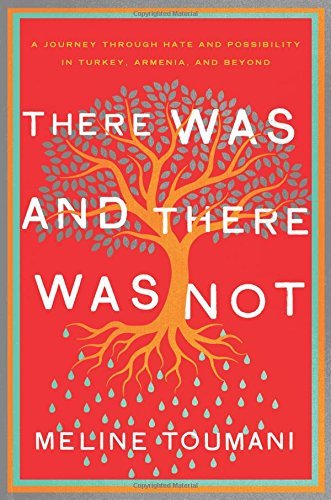‘There Was and There Was Not’ crosses Turkish-Armenian divide
By Korea HeraldPublished : Dec. 4, 2014 - 21:01
At the Armenian-American camp Meline Toumani attended each summer in Massachusetts, she and her fellow campers knew exactly what bonded them as a people. And no, it wasn’t just their adult-sized noses, at least one of which elicited the nickname “Gonzo” back at school.
It was the need for recognition ― from Turkey and the world ― that the Armenian genocide had indeed happened. Even by grade school, Toumani knew certain truths that others denied or were oblivious to: One and a half million Armenians were killed under Ottoman Turkish rule in 1915. Others were driven out, scattering around the globe in a huge diaspora.
Toumani, a New York Times reporter who was born in Iran after her family fled Armenia and raised in New Jersey, spends the first half of her memoir establishing how central the fight for recognition is to her people ― and how much it shaped her early life.
It was the need for recognition ― from Turkey and the world ― that the Armenian genocide had indeed happened. Even by grade school, Toumani knew certain truths that others denied or were oblivious to: One and a half million Armenians were killed under Ottoman Turkish rule in 1915. Others were driven out, scattering around the globe in a huge diaspora.
Toumani, a New York Times reporter who was born in Iran after her family fled Armenia and raised in New Jersey, spends the first half of her memoir establishing how central the fight for recognition is to her people ― and how much it shaped her early life.

But as she reaches adulthood, the Turks Are Evil refrain has grown tired. Toumani writes that she “could no longer stand to attend any Armenian gathering, because it seemed that whether it was a poetry reading, a concert, or even a sporting match, it was always, ultimately, about the genocide.”
So Toumani decides to move to Istanbul as part of a “project” (this book) in which she’ll try to view the Turks as people rather than the monsters she’d been told about.
The cast of characters she meets includes Turkish scholars, laymen, snobs and journalists. Some entirely ignore her when they discover her ethnicity, others become allies, a few struggle to find something nice to say: Armenians are good cooks! Above all, they prove to be surprisingly human, with varying degrees of empathy and denial.
Her impressive reporting and research skills add context as she takes us through old Armenian ruins and new interpretations of Turkish history. At the Museum of Anatolian Civilizations in Ankara, she describes a timeline that marks the “shift and jolts” of 3,000 years’ worth of civilizations. Aegean migrations, the divide of the Roman Empire and the rise of Byzantium. Then it suddenly skips from 330 to 1071, to the Seljuk Turks.
“In other words,” she writes, “the hundreds of years that comprised the height of Armenian civilization in Anatolia ― the rise and fall of several Armenian dynasties and kingdoms ― were left out of the time line all together.”
It’s one of Toumani’s many examples of the country’s seemingly official stance on Armenians: They don’t exist.
A flood of history, politics and too many characters confuses Toumani’s goal of a “soft reconciliation,” as she puts it. But it also dilutes the emotional impact of this book at points. The fiber needed to bind this together is Toumani herself ― and rather than convey the personal thrill of discovery, she sometimes gets lost in academic interludes. When this happens, “There Was and There Was Not” does resemble more of a “project” than a personal journey.
After all, some of the book’s best moments are its least assuming. In one chapter, Toumani sketches a scene at the Istanbul airport when she can’t seem to find the designated gate for her flight to Armenia. Then she spots a familiar crowd of people who “less resemble passengers in a check-in line than practiced Soviets jockeying for the last loaf of bread.” Armenians.
Older women with “puffs of blue-black and purple-gray hair,” who wore “calf-length skirts and smooth blouses, armored bras aiming their hefty bosoms at ninety degrees, challenging anybody to dare block their path,” she writes. “There were also a few slender Armenian girls in skintight jeans, amply rouged, with silky long hair, wearing stiletto heels and tank tops, fake breasts distorting fake logos. . . . Yes, here they were, my people.”
Toumani’s final analysis about her experience/experiment in Turkey is sure to spur arguments on both sides. But with this book, she gives her people a bit of what they are asking for ― recognition ― while considering that there is always another side to the story.
By Lorraine Ali
(Los Angeles Times)
(Tribune Content Agency)
-
Articles by Korea Herald







![[Graphic News] More Koreans say they plan long-distance trips this year](http://res.heraldm.com/phpwas/restmb_idxmake.php?idx=644&simg=/content/image/2024/04/17/20240417050828_0.gif&u=)
![[KH Explains] Hyundai's full hybrid edge to pay off amid slow transition to pure EVs](http://res.heraldm.com/phpwas/restmb_idxmake.php?idx=644&simg=/content/image/2024/04/18/20240418050645_0.jpg&u=20240419100350)






![[From the Scene] Monks, Buddhists hail return of remains of Buddhas](http://res.heraldm.com/phpwas/restmb_idxmake.php?idx=652&simg=/content/image/2024/04/19/20240419050617_0.jpg&u=20240419175937)

![[KH Explains] Hyundai's full hybrid edge to pay off amid slow transition to pure EVs](http://res.heraldm.com/phpwas/restmb_idxmake.php?idx=652&simg=/content/image/2024/04/18/20240418050645_0.jpg&u=20240419100350)

![[Today’s K-pop] Illit drops debut single remix](http://res.heraldm.com/phpwas/restmb_idxmake.php?idx=642&simg=/content/image/2024/04/19/20240419050612_0.jpg&u=)